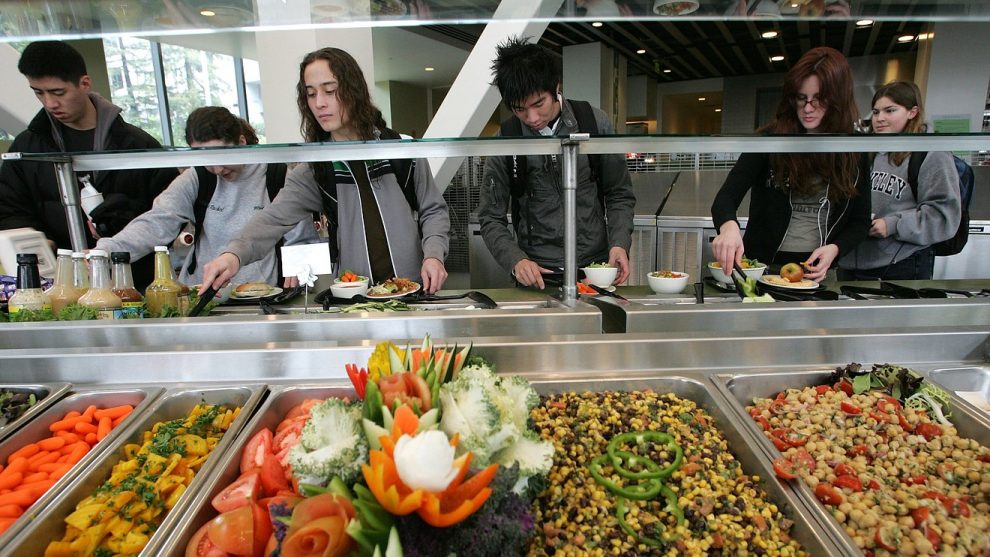
College students spend their days lounging on the quad, studying in the library, partying with their friends and, many people likely assume, largely immune from the challenges plaguing those of us in the “real world.”
But evidence has accumulated in recent years, indicating that college students across the country are struggling to make ends meet — and, in some cases, not even getting enough food to eat.
Some 45% of college students say they experience ‘food insecurity’ — meaning they have limited or uncertain access to nutritious food.
Some 45% of college students say they experience “food insecurity” — meaning they have limited or uncertain access to nutritious food, according to a nationwide survey released Tuesday that captured data from 86,000 students and 123 colleges. The survey was carried out by the Hope Center for College Community and Justice at Temple University in Philadelphia.
Food insecurity can include skipping or cutting down the size of meals due to lack of food, worrying that food will run out before they get a chance to buy more and experiencing hunger due to lack of funds to afford food. This field of study is relatively new and researchers are refining the ways they measure how well college students can afford their basic needs.
More than half — 56% — of the survey respondents said they’d experienced housing insecurity in the past year and 17% said they had experienced homelessness in the past year. Now in its fourth year, this year’s survey was the largest yet.
Are you a college student struggling to afford food or housing? Email us: [email protected]
Why college students struggle to afford food and housing
A combination of factors explain why relatively high levels of college students may struggle to afford their basic needs. For one, the high costs of college, food and housing mean that students need to scrape together more money to afford to live while in school. In addition, relatively stagnant wages means that even when students do work, the may not be enough for them to get by.
What’s more, the value of a college degree has increased. That means more students from a broader range of economic backgrounds are attending college because they see the degree as essential to landing a well-paying job. Indeed, students who are already marginalized experience the challenges of food and housing insecurity most acutely, the latest study found.
About 58% of black students said they experienced housing insecurity, compared to about half of Hispanic students and 39% of white students.
About 58% of black students said they experienced housing insecurity, compared to about half of Hispanic students and 39% of white students. Students whose parents had no high-school diploma experienced the highest rates of housing insecurity at 64%, the survey found.
Student parents were more likely to experience housing and food insecurity than students without children. Students who received a Pell grant — the money the government provides to low-income students to attend college — have higher levels of food and housing insecurity than their peers who don’t receive a Pell grant.
The survey also illustrates the challenges students face affording basic needs even when they work. More than two-thirds of students who experience food and housing insecurity as well as homelessness are employed, the survey found.
Trying to work to afford college and basic needs combined with the stress of not knowing where your next meal is going to come from or whether you’ll be kicked out of the place where you’re sleeping can make succeeding in college difficult, said Sara Goldrick-Rab, founder of the Hope Center and a professor of higher education at Temple University.
“Not having enough to eat or not having a safe place to sleep is a distraction,” she said. “If you’re couch surfing, I can tell you from interviewing those students, what’s on their mind is, ‘Where am I going to sleep next?’ And that’s not what you want them doing during class.”
One New York City college student’s story
That’s an experience many college students know first-hand. Sierra, a 21-year-old college student in New York City, who preferred that MarketWatch withhold her surname to protect her anonymity, has been bouncing between homes for the past few years, including during her last two semesters in college.
Sierra, a 21-year-old college student in New York City, has been bouncing between homes for the past few years, including her last two college semesters.
Sierra, who grew up in the Bedford-Stuyvesant neighborhood of Brooklyn, has her tuition covered at the New York City College of Technology by state and federal aid. But in order to make enough money to afford food and other basic expenses, she works multiple jobs. Her busy schedule pushed her to drop down from four classes to two this semester.
“It’s not like I don’t know the work,” Sierra said. But between missing some classes to go to work and the stress of not always knowing where she’s next going to sleep or where her next meal is going to come from, “I’m barely passing the two classes that I have now,” she said.
That’s a far cry from what Sierra said she expected college to be. As a senior in high school, Sierra had hoped to leave New York City to study math or engineering at a college upstate, but a challenging family situation made her transition to college much less smooth.
“If I had all my focus towards that,” Sierra said, “that’s something that I know that I could have done. But with the circumstances, I couldn’t do that. I have to just make do with what I can.” Having reconsidered her career options, Sierra now hopes to be a social worker.
Measuring hunger and housing insecurity on campus is a relatively new field
The Hope Center’s annual findings have been relatively consistent over the last four years, and haven’t changed much based on the number of students surveyed and the mix of colleges (community and four-year) in the report.
Measuring housing and food insecurity on college campuses is something researchers and colleges have only started doing in the past several years.
That’s particularly striking to Goldrick-Rab. “Whether it’s 2016 or 2018 or whether it’s the West Coast or the East Coast or whether it’s a big community college or a little one, these numbers look incredibly similar,” Goldrick-Rab said. “I’m just a little bit flabbergasted by that.”
The question of consistency is an important one. Measuring how often students are going hungry or experiencing “housing insecurity” on college campuses is something researchers and colleges have only started doing in the past several years and quantifying the problem can be an important step towards addressing it. In addition to the Hope Center surveys, researchers from other organizations and at individual colleges or college systems are working to measure food and housing insecurity among students.
Some researchers have argued that these estimates aren’t precise enough. For example, a paper released this month by food-science and nutrition researchers at the University of Illinois argued that the way food insecurity is measured among college students “makes a substantial difference in reported prevalence.”
Goldrick-Rab noted that although the Hope Center’s findings have been relatively consistent, although there is some variation in levels of food and housing insecurity among them. In addition, she acknowledges that the survey’s response rate is “abysmally low” at 5.8%. (Although they received 86,000 responses, researchers sent the survey to nearly 1.5 million students.)
But that the levels of food insecurity are above 40% for community college students and more than half of those students are “housing insecure” across four annual surveys indicates that students are facing challenges affording their basic needs, she said.
Quantifying the experiences of students like Sierra in some way is important to ensure colleges and local and federal governments work to address their challenges, Goldrick-Rab said. “We only seem to care about what we count,” she added. “If we don’t have these numbers then people seem to think were just telling them sad stories.”
What schools can do to address the problem
The Hope Center report recommends colleges adopt a variety of proposals to help ensure their students aren’t stressed about food and housing while in school. They include appointing a director of basic needs, working with the business community to provide students with help such as vouchers for subsidized housing or giving students the ability to share their meal swipes with one another.
In addition, colleges should be more engaged in advocating for increased access to federal government safety-net programs for students, the report suggests. More than half of low-income college students at risk for food insecurity didn’t participate in the food stamp program, even though they could qualify for the benefit, according to an analysis by the Government Accountability Office.
That can sometimes happen because campus officials don’t realize their students may be eligible for food stamps, the GAO report found. In fact, the Hope Center study also found relatively low rates of food-stamp use — around 30% — among students experiencing food insecurity.
“That just worries me a lot,” Goldrick-Rab said.
Get a daily roundup of the top reads in personal finance delivered to your inbox. Subscribe to MarketWatch’s free Personal Finance Daily newsletter. Sign up here.









